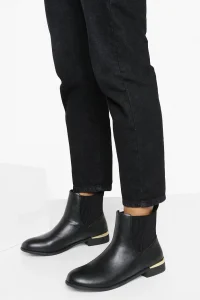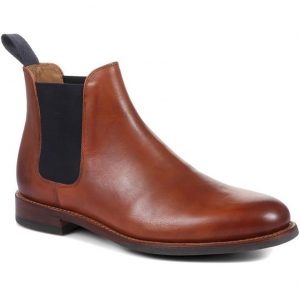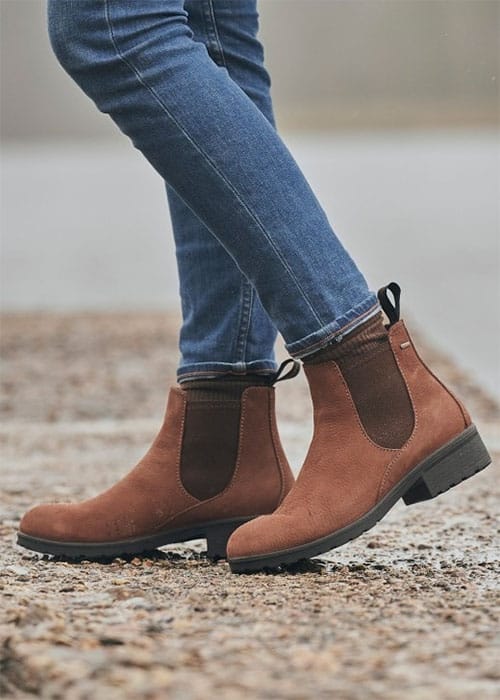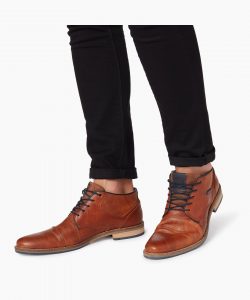Alfred and Emma Jones opened a footwear shop in Bayswater, London, in 1857. They were married in 1858. Jones was a trailblazer when it came to the installation of electric lighting in retail establishments. Nine of their eleven sons went on to become apprentices and, eventually, store owners, operating under the name A. Jones and sons. One of the company’s innovations was the provision of ready-made shoes in three different widths.
Following the Second World War, the company expanded, establishing a warehouse in Eastbourne, modernising existing stores, and opening new branches across the country. In 1955, the expansion of Jones’ retail outlets outpaced the company’s ability to produce at its factory, and the company joined the Church’s group of companies. In 1994, a ‘City Bootmaker’ shop was established in Manchester, and the company went into business as Jones Bootmaker in 1996.
The Jones Bootmaker UK company was sold to a private investor in 2001, and then to a financial consortium in 2006. This followed the purchase of Church’s by Prada in 1999. Previously, it was sold to the Macintosh Retail Group in 2010, and then again in 2015 to Alteri Investors, which was backed by Apollo Global Management.
Alteri filed a notice of intent to appoint administrators for Jones on March 15, 2017, and the company was purchased by Endless LLP in a pre-pack administration deal on March 26, 2017, resulting in the survival of 72 stores.
Pavers Shoes purchased the chain from Endless in February 2018, and it has been in use since then.
ones Bootmaker, Britain’s premier heritage footwear retailer, today announced the launch of their ‘Made in Britain’ menswear footwear collection for the upcoming autumn/winter 2016 season. Known for its eccentricity, quality, and heritage, the collection reinvents and references the quintessential aspects of Britishness.
As of today, Pavers has taken control of 42 of the heritage footwear retailer’s remaining 47 stores, as well as the Jones Bootmaker website and branding.
DEAKIN LEATHER CHELSEA BOOTS
A soft sheepskin footbed gives Deakin the perfect Chelsea boot feel. I wear it from winter to spring and it’s a staple in my wardrobe. The Deakin collection has been delicately crafted in a variety of colours to suit every occasion, whether you prefer suede or leather.
Jones Bootmaker, the premier heritage footwear retailer in the United Kingdom, today launched their ‘Made in Britain’ menswear footwear collection for the upcoming autumn/winter 2016 season. Known for its eccentricity, quality, and heritage, the collection reinvents and references the quintessential aspects of Britishness.
Chelsea boots are ankle-high boots that are close-fitting and have an elastic side panel. Their backs are frequently embellished with a loop or tab of fabric to allow them to be pulled on and off more easily. Originally worn by both men and women during the Victorian era, the boot has been around for a long time.
Throughout the 1960s in Britain, particularly in the mod scene, Chelsea boots and some of their variants were considered to be an iconic part of the decade.
Queen Victoria, according to the shoemaker Joseph Sparkes Hall, walked around in them on a daily basis, which “provides the strongest proof of the value she attaches to the invention.” J. Sparkes Hall’s Patent Elastic Ankle Boots is the name of the boot that he advertises in his advertising from the time period. The boot gained popularity not only for walking but also for horseback riding.
As a result of Charles Goodyear’s research into the properties of vulcanised rubber, the elastic gusset boot came about. The advantage of elasticized boots was that they could be taken off and put back on with relative ease. By the late 1840s, the style had begun to gain popularity. Until the outbreak of World War I, this was a popular fashion trend in the Western world.
When Chelsea boots first became popular in the United Kingdom in the 1950s and 1960s, they were associated with the King’s Road (a street in Chelsea and Fulham, in inner western London) set of Swinging London, which was worn by everyone from the Rolling Stones to Jean Shrimpton. It is believed that this association is what led to the name “Chelsea” being associated with the boot.
Here’s a preview of a premium action of Deakin leather chelsea boots by Jones Bootmaker UK:

BAYRIDGE LEATHER GOODYEAR WELT CHELSEA BOOTS
An outsole with a strip of leather, rubber, or plastic running around the perimeter is known as a Goodyear Welt shoe or Goodyear Welt boot… The upper is first stitched together with a welt. Afterwards, a strip of canvas is cemented to the insole of the shoe in order to serve as a point of attachment for the shoe’s sole.
Because the stitches in a goodyear welted shoe are separated by a leather barrier, they tend to be more water resistant than other types of shoes. Shoes that have been goodyear welted are generally more durable, tend to last longer, and are more comfortable.
It is the piece of leather that runs along the outsole of the shoe and serves to connect the upper of the shoe to the sole of the shoe that is referred to as a welt. The welt type is one of the most important indicators of well-made, high-quality shoes.
In comparison to other types of shoes, Goodyear welted shoes are the most straightforward to resole and can be resoled numerous times. But, once again, it causes a small amount of damage to the bottom of the shoe with each wear. And, in many cases, the upper is of such poor quality that it isn’t even worth it.
You may have heard someone mention Goodyear Welted shoes and wondered why they were so much more expensive than the shoes you could buy on the high street. This is due to the high cost of production and the amount of labour required. The advantages are numerous, and if you’re looking for a pair of shoes that is durable, stylish, and sophisticated, look no further than these.
Here’s a preview of Bayrtidge leather chelsea boots by Jones Bootmaker UK:

CHIGWELL LEATHER CHELSEA BOOTS
J. Sparkes-Hall, Queen Victoria’s cobbler, created the first Chelsea boot in England in 1837, and it is still in use today. They were referred to as ‘paddock boots’ at the time because they had elasticated sides made of vulcanised rubber, which saved time.
Chelsea boots got their name from their widespread use in Chelsea, a fashionable and affluent district of London, during the 1950s and 1960s, particularly among members of the’mod’ subculture of the time.
There is compelling evidence to suggest that Mr J Sparkes-Hall, Queen Victoria’s bootmaker, designed the first Chelsea boot in 1837, and that it was made by him. It was reported that he designed a pair of ankle-height boots with elastic inserts on either side to make them easier to put on and take off for her majesty’s convenience.
Despite the fact that Common Projects, an Italian-American luxury footwear label, is the last word in premium sneakers, that is by no means the extent of the brand’s abilities. With the exception of its now-iconic Achilles Low shoe, CP’s Chelsea boot is the silhouette for which the company is most well-known.
Everyone should own a pair of Chelsea boots for a variety of reasons, the most important of which is their versatility. From skinny jeans to a tailored three-piece suit, you can pair them with almost anything. Because of their attractiveness, they are considered to be among the best dress boots for both men and women.
Here’s a preview of Chigwell leather chelsea by Jones Bootmaker UK:









